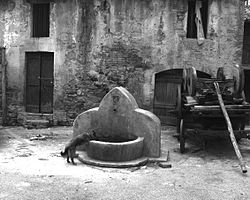Bevagna
Bevagna | |
|---|---|
| Comune di Bevagna | |
 Bevagna | |
| Country | Italy |
| Region | Umbria |
| Province | Perugia |
| Frazioni | Cantalupo di Bevagna, Gaglioli, Limigiano, Torre del Colle, Campofondo, Castelbuono, Madonna della Pia |
| Government | |
| • Mayor | Enrico Bastioli |
| Area | |
| • Total | 56 km2 (22 sq mi) |
| Elevation | 210 m (690 ft) |
| Population (2004)[2] | |
| • Total | 5,013 |
| • Density | 90/km2 (230/sq mi) |
| Demonym | Bevanati |
| Time zone | UTC+1 (CET) |
| • Summer (DST) | UTC+2 (CEST) |
| Postal code | 06031 |
| Dialing code | 0742 |
| Patron saint | Saint Vincent |
| Saint day | June 6 |
| Website | Official website |
Bevagna is a town and comune in the central part of the Italian province of Perugia, (Umbria), in the flood plain of the Topino river.
Bevagna is 25 km (15 mi) SE of Perugia, 8 km west of Foligno, 7 km north-north-west of Montefalco, 16 km south of Assisi and 15 km (9 mi) north-west of Trevi.
It has a population of c. 5,000, with the town of Bevagna proper accounting for about half of that.
History
The city was originally an Etruscan-Oscan settlement. Around 80-90 BC it became a Roman municipium, called Mevania. In the 3rd-4th centuries AD it was probably an episcopal see and, after the Lombard conquest, the seat of a gastald in the Duchy of Spoleto.
After the year 1000 it was a free commune. In 1152 Frederick Barbarossa set it on fire. In 1249 it was again destroyed by the Count of Aquino. In 1371-1439 it was ruled by the Trinci family. Later it was part of the Papal States until the unification of Italy.

The painter Andrea Camassei (1602 - 1649) was born in Bevagna.
Main sights
- Palazzo dei Consoli, known from 1187, with Teatro F. Torti (1886)
- Romanesque church of S. Michele Arcangelo (12th-13th centuries)
- Romanesque church of S. Silvestro (1195).
- Church of Sant'Agostino (1316).
- Church of San Nicolò.
- Church of Santa Maria in Laurenzia, built in the 13th century and later enlarged.
- Church of San Vincenzo (known from the 12th century).
- The medieval walls.
- Ruins of a Roman Temple.
- Ruins of a Roman Theater.
- Roman Therme with mosaics of marine life.
- Castle of Cantalupo.
- Castle of Castelbuono.
- Church of Limigiano.
- Castle of Torre del Colle.
Culture
Main events held in Bevagna include:
- Primavera medievale (April): exposition of local culinaric and artistical products held by the Associatione Mercato delle Gaitte.
- Arte in Tavola (end of April): Spring festival with exhibitions by local artists, concerts, exhibitions of local products and dishes with degustation.
- Mercato delle Gaite (June): big summer festival with medieval banquettes, processions, challenges between the four gaite (quarters) and taverns.
The four Gaite of Bevagna are San Giorgio, San Giovanni, San Pietro and Santa Maria.
External links
- Official website
- Pro Loco Bevagna
- Bevagna.Net
- Mercato del Gaite - all about the festivals (in Italian)
- ^ "Superficie di Comuni Province e Regioni italiane al 9 ottobre 2011". Italian National Institute of Statistics. Retrieved 16 March 2019.
- ^ "Popolazione Residente al 1° Gennaio 2018". Italian National Institute of Statistics. Retrieved 16 March 2019.

